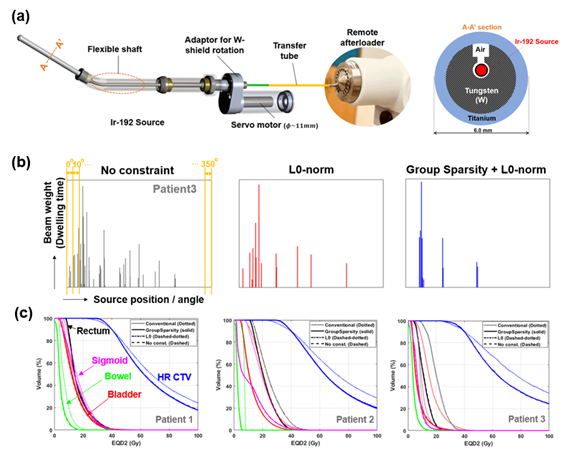글로벌 연구동향
의학물리학
- 2020년 11월호
[PLoS One.] Plan optimization with L0-norm and group sparsity constraints for a new rotational, intensity-modulated brachytherapy for cervical cancer 최신 자궁경부암 치료 기법인 세기조절근접방사선치료를 위한 치료계획 최적화 연구국립암센터, 울산의대 / 김호진, 임영경*, 곽정원*
- 출처
- PLoS One.
- 등재일
- 2020 Jul 28
- 저널이슈번호
- 15(7):e0236585. doi: 10.1371/journal.pone.0236585. eCollection 2020.
- 내용
-
Abstract
The aim of this work is to build a framework that comprehends inverse planning procedure and plan optimization algorithm tailored to a novel directional beam intensity-modulated brachytherapy (IMBT) of cervical cancer using a rotatable, single-channel radiation shield. Inverse planning is required for finding optimal beam emitting direction, source dwell position and dwell time, which begin with creating a kernel matrix for each structure based on Monte-Carlo simulated dose distribution in the rotatable shield. For efficient beam delivery and less transit dose, the number of source dwell positions and angles needs to be minimized. It can be solved by L0-norm regularization for fewest possible dwell points, and by group sparsity constraint in L2,p-norm (0≤p<1) besides L0-norm for fewest active applicator rotating angles. The dose distributions from our proposed algorithms were compared to those of conventional tandem-based intracavitary brachytherapy (ICR) plans for six cervical cancer patients. The algorithmic performance was evaluated in delivery efficiency and plan quality relative to the unconstrained algorithm. The proposed framework yielded substantially enhanced plan quality over the conventional ICR plans. The L0-norm and (group sparsity+L0-norm) constrained algorithms reduced the number of source dwell points by 60 and 70% and saved 5 and 8 rotational angles on average (7 and 11 angles for highly modulated cases), relative to the unconstrained algorithm, respectively. Though both algorithms reduced the optimal source dwell positions and angles, the group sparsity constrained optimization with L0-norm was more effective than the L0-norm constraint only, mainly because of considering physical constraints of the new IMBT applicator. With much fewer dwell points compared to the unconstrained, the proposed algorithms led to statistically similar plan quality in dose volume histograms and iso-dose lines. It also demonstrated that the plan optimized by rotating the applicator resulted in much better plan quality than that of conventional applicator-based plans.
(a) 회전 차폐체로 구성된 새로운 근접치료 삽입기구, (b) 본 연구에서 제안한 수학적 모델을 기반으로 구현한 치료계획 결과, (c) 일반적인 근접치료계획 및 다른 최적화 알고리즘으로 생성된 세기조절 근접치료계획의 선량-체적 히스토그램 (Dose-volume histogram) 비교
Affiliations
Hojin Kim 1 , Young Kyung Lim 2 , Youngmoon Goh 1 , Chiyoung Jeong 1 , Ui-Jung Hwang 3 , Sang Hyoun Choi 4 , Byungchul Cho 5 , Jungwon Kwak 5
1 Department of Radiation Oncology, Asan Medical Center, Seoul, Korea.
2 Proton Therapy Center, National Cancer Center, Goyang, Korea.
3 Department of Radiation Oncology, Chungnam National University Hospital, Daejeon, Korea.
4 Department of Radiation Oncology, Korea Cancer Center Hospital, Seoul, Korea.
5 Department of Radiation Oncology, Asan Medical Center, University of Ulsan College of Medicine, Seoul, Korea.
- 연구소개
- 국내 연구진은 최근 회전 차폐체를 이용한 세기조절 근접방사선치료(Intensity Modulated Brachytherapy; IMBT) 방식을 고안했습니다. 일반적인 근접치료의 경우 방사선원이 특정 위치에서 머무르는 시간(dwell time)을 최적화하는 방식으로 치료계획이 이루어졌다면, 회전 차폐체를 이용한 IMBT는 방사선원의 위치에 더하여 방사선 방출각도라는 변수를 추가하여 비대칭 형태의 종양을 가진 환자들에 대한 효과적인 치료를 기대하고 있습니다. 새로운 IMBT의 치료계획을 위해서는 회전 차폐체에서 선원의 위치와 차폐체 회전각도를 최적화할 수 있는 역방향 치료계획(inverse planning)이 요구됩니다. 치료의 효율성 향상 및 치료 중 통과누설 방사선량 (transit dose)를 감소시키기 위해 회전 차폐체의 물리적인 특성이 치료계획 최적화에 반영되어야 합니다. 본 연구에서는 방사선치료의 효율성을 극대화하면서 동시에 치료계획의 품질을 동일하게 유지할 수 있는 치료계획 최적화 알고리즘을 제안하였습니다. L0-minimization 과 group-sparsity 라는 수학적인 모델을 통해 각각 물리적으로 최적화된 방사선원의 위치와 회전각도의 개수를 최소화할 수 있는 치료계획 최적화를 구현했습니다. 제약조건이 없는 일반적인 치료계획 알고리즘과 비교했을 때, 방사선원의 개수는 평균 68% (30.5 → 9.8), 회전 각도 수는 8개 (12.7 → 4.7)를 감소시킬 수 있었으며, 치료계획의 품질은 동일하게 유지되고 있음을 확인할 수 있었습니다.
- 덧글달기








편집위원
세기를 조절할 수 있는 근접방사선치료기는 아직 상용화되지는 않았지만, 상용화된다면 좋은 방사선 치료 modality가 될 것임. 역방향 치료계획을 위해서는 최적화가 필수인데, 빠르고 정확한 최적화를 위한 방법을 제시한 것 같음
덧글달기닫기2020-11-10 09:53:44
등록